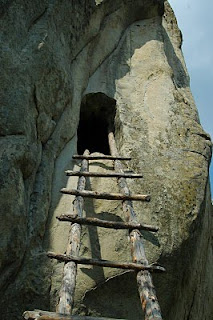Bozioru is a commune in Buzău County, Muntenia, Romania. It is situated on Bălănesei Valley - a tributary Buzău River, at 15-20 km of national road Buzău-Nehoiu, in the Crucea Spătarului Mountains (Curvature Carpathians).
Here are many churches and monastic settlements carved into the sandstone and limestone, by the hermits withdrawn from the men. Because of its age, the area is considered by some scholars as the cradle of Christianity in Romania. Cave relics were first inventoried in 1871 by historian and writer Alexandru Odobescu.
The oldest settlement of the nearly 20 in the hermitages complex, is the grotto named 'Fundul Peşterii", which has been inhabited since the 6th century BC. It has on walls several inlaid undecipherable writings, in a local alphabet. In the 4th century AD, Byzantine Emperor Constantius II exiled in the Buzău area the Orthodox dissident Christian sect of Audiens; it seems that Audians came from Mesopotamia, that explains the representation of Persian daggers on the walls of some hermitages. Can be seen also pre-Christian and proto-Christian signs: akinakes swords, the fish, crosses, inscriptions with Greek letters, a sort of runes, etc.
The complex comprises nearly 20 caves, grottoes, and hermitages carved in rock, including Old Agathon, New Agathon, Hawk's Stone I and II, the Ravine I and II, the Kitchen, Iosif's Rock, Dionisie the Spinner's Cave. Iosif's Cave is 6m x 3m, has an altar an was used as meeting place for the monks and hermits until 1871.
The Wallachian Style Portal
8 hours ago






0 comments:
Post a Comment